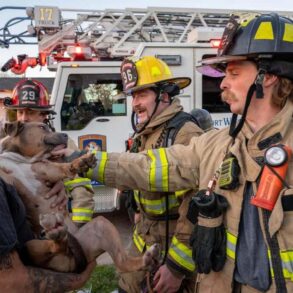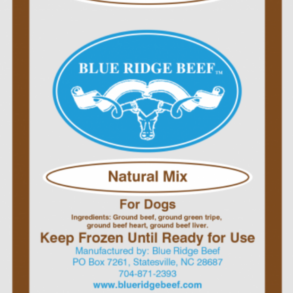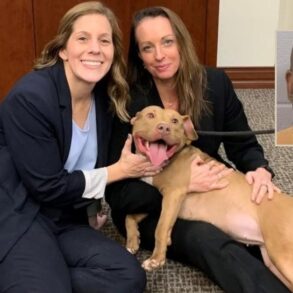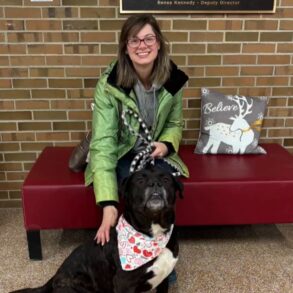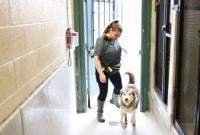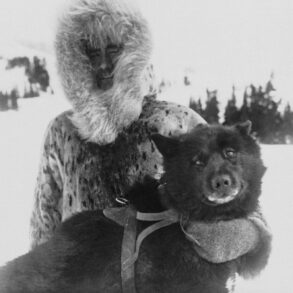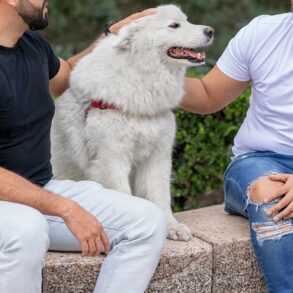Golden • Walking into her home, Chaucee Stillman’s dog Gary opens his mouth, showing off the few teeth he has left, and lets out a booming bark.
The roughly 14-year-old Chihuahua, who weighs no more than a few pounds, still likes to let visitors know he’s here.
Gary was surrendered to Stillman after his owner died, she said. When he came into her care, many of his teeth were rotten and he had mobility issues from muscle wasting.
But he wasn’t ready to go, not yet. Stillman took him to the doggy dentist where he had those bad teeth removed. With some physcial therapy, new medical treatments and a custom wheelchair for his back legs, Gary was ready to live out his golden years in style.
“When we go on walks, he’s so fast with it. He’s like, zooming around,” Stillman said.

In a cabinet in her entryway Chaucee Stillman keeps an array of supplies she might need for senior dogs in hospice care such as diapers, join supplements, dog food and grooming supplies. (Parker Seibold, The Gazette)

Chaucee Stillman uses wooden tea holders to organize medication for her foster dogs on Tuesday, Jan. 21, 2025, in Golden, Colo. (Parker Seibold, The Gazette)
As the founder of the Golden-based Colorado Senior Dog Rescue and Hospice, (coseniordogrescue.org), Stillman admitted Gary as a hospice patient. But his health improved so much that he’s now considered a long-term sanctuary foster.
Stillman started the dog rescue in December 2022. Since then, the organization has saved nearly 50 pups, specializing in senior and medically needy dogs. The nonprofit’s hospice program is designed for canine companions that are soon to cross over the rainbow bridge.
“It’s always been a dream of mine to have my own rescue that was specifically more focused on hospice because there’s not a lot,” Stillman said. “Senior dogs are less likely to get pulled from shelters, and they’re a lot more expensive to take care of.”
The rescue operates with the help of volunteer fosters. Regular fosters care for senior dogs as they look for a forever home, and hospice fosters provide a loving home for end-of-life care. Hospice care is determined on a case-by-case basis, usually considering if a dog has a chronic condition and will die within six to 12 months, Stillman said.
Recently, the organization added another category: sanctuary seniors. These dogs have long-term, chronic health needs like Gary, but can have full lives with proper care. They live with permanent fosters and the nonprofit covers their medical needs.
“The goal for sanctuary seniors is to have a dog in a loving home that gets consistent care that they need, so they’ll be the dogs that are maybe less likely to be adopted because their conditions are expensive to manage or hard to manage,” Stillman said.

Chaucee Stillman founder of the Colorado Senior Dog Rescue and Hospice demonstrates how she uses a custom wheelchair for her foster dog Gary on Tuesday, Jan. 21, 2025, in Golden, Colo. The roughly 14-year-old chihuahu was surrendered to her after his owner died. (Parker Seibold, The Gazette)
Most of the dogs that come to the rescue receive medical care upon intake, including spays/neuters and dental work, Stillman said.
“A lot of dogs, especially senior dogs, who have been found as strays or whatnot, they’ve been neglected over the years and so health issues just compound on one another,” she said.
The animals often are transferred from larger partner shelters, which reach out to Stillman when they have a senior or sickly dog. While those larger shelters often provide a general intake exam and some vaccines via an in-house veterinarian, they too have strained resources, so it can be hard to address more complex medical needs. Occasionally, the organization will take in an owner surrender.
As far as finances, the nonprofit covers medical expenses for dogs in foster and hospice care. While Stillman encourages volunteers to supply what they can, the organization also helps with food and items such as bowls, crates and leashes. The organization operates off of donations and hosts fundraising events and contests throughout the year.
When a new dog comes in, the shelter records can give Stillman a good idea of what needs the dog may have. She likes to budget at least $2,000 for each dog, regardless of need. That usually covers basic care for dogs with no complications, like dental surgeries and spays/neuters. For more medically needy dogs, that threshhold may increase to $5,000.
“We really rely on support via donations, and a lot of people actually do go above and beyond their adoption fee and donate to us,” Stillman said. “We don’t have high fees. I want people to spend their money on the dogs they adopt, and not just on crazy adoption fees.”
The rescue’s primary veterinarian is Dr. Patrick Kalenzi of Rock Creek Veterinary Hospital in Broomfield, and it also partners with several other practices around the Front Range.
While the rescue doesn’t intentionally foster to adopt, “foster fails” do happen.
“I’m always down for people to foster fail because they obviously take good care of the dog, and the dog knows them and is comfortable with them,” Stillman said.
Veterinary assistant Elysse Waka “foster failed” her first time working with the Colorado Senior Dog Rescue and Hospice. This past summer, Waka was looking to foster an older dog when she found the nonprofit online. She had volunteered as a foster before with other organizations, but was drawn to how personal this rescue felt, she said.
“I just see how much fostering can help dogs in the shelter, especially older dogs who often get looked over,” Waka said. “Just getting them out of that environment and back into a home, or even at home for the first time is pretty special.”
So, she applied and was approved to foster. Soon, she was paired with Mimi, a 12-year-old, toothless terrier mix, whose tongue permanently sticks out. Mimi was found as a stray and taken in by the Denver Animal Shelter.
When Mimi arrived, she seemed confused and unsure.
“She was so closed off; she was so anxious. She would pace around the house and would just never really settle,” Waka said.
But it didn’t take long for the pup to warm up to her new home and act like a dog.
“She has such a great big personality now. She begs for food, which she’s never done before, and she knows her way around the house now, so she’ll follow us. She’ll run behind us. She’ll go in the backyard and actually go sniff around and come back in,” Waka said. “It’s just really cool seeing her personality come through. And I mean, we just fell in love with her.”
So, when applications started to come in to adopt Mimi, Waka decided that she couldn’t part with the goofy pup she had grown to love. And even though she might have “failed” at being a temporary home, Waka still encourages those who can to foster, especially those dogs that are often overlooked.
“Sometimes it’s learning to love again and trust humans again. Sometimes, it’s learning it’s OK to take a nap, and close your eyes and know you feel safe,” she said. “It’s special, knowing that you can give them everything they deserve whether it’s in their final moments, whether it’s for two weeks, or it’s for three days. It’s just special knowing that you made a difference in that dog’s life.”
With older dogs, trust is key, said Morgan McMurdy, who partners with the nonprofit to provide training. McMurdy, a certified professional dog trainer-knowledge assessed, has been working with dogs for more than 16 years. She owns Switchback K-9 and specializes in behavior-related work.
Each adopter gets a free virtual session with McMurdy upon adoption, where they can address questions, including how to make the adjustment a bit smoother. From there, McMurdy offers adopters a discounted rate if they’re interested in working with her.
“Some of these senior dogs are going out to homes with still plenty of life left in them, and you can teach an old dog new tricks. Helping them just fit into their new home is all it needs to make sure that it’s like a long and happy, successful adoption,” McMurdy said.
Following the rule of threes is important, McMurdy said, where people can expect to see their pups warm up to their new surroundings between three weeks to three months, especially with seniors.
“They’re going through a big change a lot of times, sometimes with their previous owners for like, 14 years, and having your whole life be one thing and suddenly everything turned upside down could be really jarring, and you get a lot of dogs that appear more shut down,” McMurdy said.
“They’re not really going to show their true colors until they start to feel really safe and comfortable.”
Senior dogs can come with unique issues, especially if they’re adjusting to a new environment for the first time since they were a puppy. Sometimes, it’s more about teaching them how to learn than it is about teaching new things, McMurdy said.
“You can also run into little bit more of anxiety-related things that you’re not used to in a younger dog, that sometimes stems from things like dementia,” McMurdy said.
“When their bodies start to fail them, if they’re starting to lose their sight, new fears pop up for them and it doesn’t present the same way as you see it in younger dogs.”
Stillman recalled one experience with a mama that was rescued at 7 years old from a puppy mill. She had never been outside a cage.
“She didn’t know how to dog, she was just terrified of everything, and so Morgan really helped rehab her to a point where she’s now in an adoptive home with someone who is excellent for her and knows how to work with her,” Stillman said.
It’s rewarding, too.
“You get a lot of life back in them too, when you kind of develop that relationship and build their repertoire,” McMurdy said.
One of the most common questions Stillman gets is “How?” How are you able to stand the emotional toll of working with senior pups? Holding Gary warm on her lap, with the roots of his gray hair turning white, she said, “These dogs deserve someone whose heart breaks when they pass.
“They deserve that deep of love and commitment, that their person misses them,” she said. “Even if it’s hard for me, even if my heart breaks. It’s what they deserve.”
This post was originally published on this site be sure to check out more of their content.







